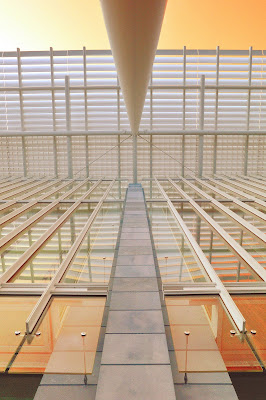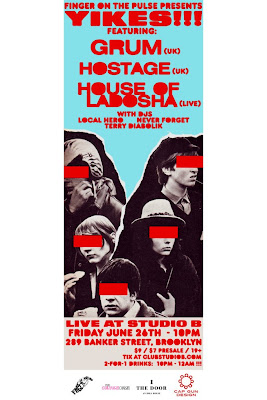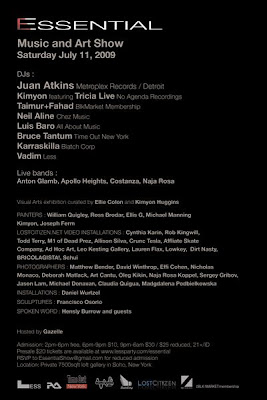
Tuesday, June 30, 2009
Friday, June 26, 2009
Thursday, June 25, 2009
2nd Annual Performing Arts Marathon
A complete schedule of Performing Arts Marathon 2009 is below.
PRODUCTIONS:
Barceloneta, at Night
Fragments
Bed for Two (Cama para dos)
Too Much Light Makes The Baby go Blind
Fotomatón
Silence & ( (( PHONATION )) )
Loisaida Kathak: Home at Last
ACTion: 2009 Showcase "Hecho en Ecuador"
Latin Choreographers Festival 2009
M15 Bus to 2nd Ave. and 4th Street
General Admission: $20.00
Buy Tickets: www.TeatroIATI.org
Tuesday, June 23, 2009
Wednesday, June 17, 2009
Mermaid Parade 2009

A completely original creation of Coney Island USA, the Mermaid Parade is the nation's largest art parade and one of New York City's greatest summer events.
The Mermaid Parade celebrates the sand, the sea, the salt air and the beginning of summer, as well as the history and mythology of Coney Island, Coney Island pride, and artistic self-expression. The Parade is characterized by participants dressed in hand-made costumes as Mermaids, Neptunes, various sea creatures, the occasional wandering lighthouse, Coney Island post card or amusement ride, as well as antique cars, marching bands, drill teams, and the odd yacht pulled on flatbed. Each year, a different celebrity King Neptune and Queen Mermaid rule over the proceedings, riding in the Parade and assisting in the opening of the Ocean for the summer swimming season by marching down the Beach from the Boardwalk, cutting through Ribbons representing the seasons, and tossing fruit into the Atlantic to appease the Sea Gods.


Source
BAMcinema FEST
This festival launch is in celebration of the tenth anniversary of BAMcinematek - which began on July 1, 1999 with the “Summer of Spike” series and a screening of Spike Lee’s “Malcolm X” (1992). BAMcinematek is initiating this festival to “screen recent films in a festival atmosphere including filmmaker Q&As, late-night films, free outdoor screenings, an all-night film marathon, and other special events.” A portion of the first BAMcinemaFEST’s festival programming will honor ten years of repertory film screenings at BAM.
An evolution in BAMcinematek’s programming, the festival will effectively replace the Sundance at BAM series, which for the past few years brought films from the Sundance Film Festival to Brooklyn.| | The first annual BAMcinemaFEST opens with the New York premiere of Don't Let Me Drown, a beautiful and understated Brooklyn love story. This breakout feature film debut by Cruz Angeles was one of the major discoveries of the 2009 Sundance Film Festival. Co-presented by Sundance Posse. More |
| | BAMcinemaFEST presents eighteen new films that provide a snapshot of some of the most vital new voices in independent cinema today. Most screenings followed by Q&As with artists. More |
| | What's a summer film festival without outdoor screenings? BAMcinemaFEST presents two dynamic and entertaining documentaries for your outdoor viewing pleasure. More |
| | BAMcinemaFEST presents 29 short films, including animation, narrative, documentary, and experimental work. Each program features Q&As with a selection of the filmmakers. More |
| | BAMcinemaFEST presents the Centerpiece Event, a special all-night celebration featuring two performances by Irish rock collective 3epkano with their original score for Fritz Lang's Metropolis, followed by an all-night movie marathon on all four screens. More |
| | In this sidebar, the BAMcinematekalogue, we pay tribute to unique moments in BAMcinematek's ten-year history with a series of special repertory film screenings. More |
Tuesday, June 16, 2009
PopRally: Blood Transfusion for a Ghost

| Saturday, June 20, 2009 7:00–11:00 P.m. P.S.1 Contemporary Art Center |
In celebration of the summer solstice, PopRally presents an evening of ritualistic, mysterious, and mystical performances, music, film, and spoken word. Artist Frank Haines has assembled four performers—the trio Blanko & Noiry; 16mm filmmaker Rose Kallal and curator Mark Beasley; psychedelic metal band Miracle of Birth; and poet Cedar Sigo—each of whom will perform in a different corner of a single gallery. ARP (DFA/Smalltown Supersound) will provide musical transitions between each performance. In a reference to his artistic relationship to the cult filmmaker Kenneth Anger, Haines borrowed this event's title from Hugh Kenner's novel The Pound Era, in which the author notes that Pound "came to think of translation as a model for the poetic act: blood brought to ghosts...essentially creating new life from old texts." Anger's current P.S.1 exhibition will be on view throughout the evening. |
Listen Up! WarmUp 2009 Summer Music Line-Up!

Published Monday, June 15, 2009.
P.S.1 Contemporary Art Center proudly announces the eleventh annual Warm Up music series line-up. The heart of P.S.1’s summer season, this historic outdoor series has set the tone for exposing New York to the best in experimental music and live DJs. This year, the Warm Up experience will merge with a new courtyard installation, Afterparty, created by the winners of the 2009 Young Architects Program, MOS.
Produced by P.S.1 Director of Operations and Exhibitions Antoine Guerrero and curated by Jason “DJ Spun” Drummond (Rong Music) and Zach Layton (Issue Project Room), Warm Up 2009 will offer a wide-scale program of bands, DJs, and musical experimenters who will take the stage for ten Saturdays over the summer. Highlights include live performances by ethereal rock group Stars Like Fleas, improvisational composer Elliott Sharp, legendary guitarist Glenn Branca, a special set by Arthur’s Landing playing the music of Arthur Russell, and DJ sets by Club Shelter’s Timmy Regisford, acid house DJ Danny Wang, and Chicago house DJ Pierre.
“Warm Up will present a dizzying and dazzling array of artists, ranging from the psychedelic to the sublime, deep rhythms and ecstatic sounds to move the body and blow the mind. From Acid House to No Wave, electronic to organic, Chicago to Detroit, and Berlin to New York. This summer will take us both back to our roots and into the future,” assures Drummond and Layton.
2009 Line-Up
July 4th
Reagenz featuring Jonah Sharp (Space Continuum) & Move D (extended live set)
Dan Bell (DBX) (DJ set)
July 11th
Arthur's Landing plays the music of Arthur Russell
Danny Wang (Balihu, NYC/Berlin)
MV Carbon & Aki Onda
July 18th agnés b. presents...
SPANK DJs SeanB and DJ Will
Cheveu (Born Bad label)
Xeno & Oaklander (Wierd Records)
DJ Pieter (Wierd Records)
July 25th
Alexi Delano (AD Music, NYC)
Derek Plaslaiko (the Bunker/Specral, Queens)
Elliott Sharp's Carbon (with Zeena Parkins, David Weinstein, and many others)
August 1st
Balance Recordings & NDATL hosts
Chez Damier (Chicago)
House of House (Live/DJ, Whatever We Want NYC)
Kai Alce (Atlanta)
Stars Like Fleas
August 8th
Music Committee of the Merce Cunningham Dance Company: Stephan Moore and John King
Eats Tapes
Lovefingers
with special guests
August 15th
Afro Acid hosts
DJ Pierre (Chicago)
Phuture 303 (Chicago)
House of Stank (New York)
Growing
August 22nd
Brennan Green (Chinatown)
John Selway (CSM)
Tim Love Lee (Tummy Touch)
Talibam!
with special guests
August 29th
Timmy Regisford (Area Code) & Club Shelter)
Duane Pitre
September 5th
Rong Music with Glenn Branca and special guests
More Info
The Summer White Dress
Is been a while since I've done some hand pick fashion fuckery.
Summer is here, well it has been trying... I am yet awaiting for a Sunny bright 80 F in NYC.
Blah Blah... So clearly one most have piece is obviously the one precious little white summer dress.
Here are my fav's:



Klaus Moje: Painting with Glass





Until September 20th, 2009
A major force in the international studio glass movement, Klaus Moje has pushed the expressive and technical possibilities of glass for more than five decades. In this comprehensive, 30-year survey, the Museum of Arts and Design traces the progression of Moje's work, from his early carved crystal glass pieces, to his intricately patterned vessels of layered glass, to his recent multi-panel fused works.
Klaus Moje features 68 objects, including a new large-scale mural made specifically for this exhibition as well as many never-before-shown works from private collections. The exhibition illustrates the dominant shapes and aesthetics of the artist's work and reflects his unparalleled contributions to the field of glass art.
Moje's work is an exploration of color--the kind of saturated, luminescent color that is only possible with glass--and his works of fused glass are elaborate, abstract arrangements of brilliant hues. He chose early in his career to work with standardized set of reductive shapes--the circle, the square--that invoke the historic form of a functional shallow bowl. In later years, he occasionally expanded his repertoire to include simple cylinders and boxes, and most recently, flat panels. Within this fairly rigid format, he has experimented with dramatic color contrasts and with geometric and abstract pattern to create a body of work that is exceptional in its richness and beauty.
Source
The Art Institute of Chicago: The Modern Wing








Renzo Piano Embraces Chicago
By NICOLAI OUROUSSOF
CHICAGO — America has been suffering from Renzo Piano fatigue.
For years Mr. Piano seemed to be snapping up all the best commissions: the renovation of the Morgan Library & Museum in Manhattan, a science center in San Francisco and museum additions in Los Angeles, Boston, Chicago and Fort Worth. (He even designed The New York Times Building.)
Many of his peers gripe that this is because of the subdued nature of his designs — sophisticated but not too threatening or unfamiliar — which seem tailored to ease the insecurities of museum boards. Some envy his elegance, which makes him seem equally at home in corporate boardrooms and lofty cultural circles.
It’s hard to know how these qualities will play out amid the gloom and doom of the new economy. In some ways Mr. Piano’s refined, risk-averse architecture may be more appealing than ever. He is not out to start a revolution. His designs are about tranquillity, not conflict. The serenity of his best buildings can almost make you believe that we live in a civilized world.
The new $294 million Modern Wing of the Art Institute of Chicago, which opens on Saturday, is the closest Mr. Piano has come in at least a decade to achieving this near-classical ideal. Its delicate structural frame is a sparkling counterpart to the museum’s 1893 Beaux Arts building. The light-filled galleries show the Art Institute’s marvelous collections of postwar and contemporary art in their full glory, including many works that have been buried in storage for decades. Most of all, the addition manages to weave the various strands of Chicago’s rich architectural history into a cohesive vision, one that is made more beautiful by its remarkable fragility.
The 264,000-square-foot wing is the largest expansion in the museum’s 130-year history. The addition stands behind the original building, across a set of commuter railroad tracks. The two structures are joined by a small gallery building from 1916 that bridges the tracks. Millennium Park, its far end punctuated by the swirling steel forms of Frank Gehry’s band shell, extends to the north.
Seen from the park Mr. Piano’s structure immediately brings to mind the work of Mies van der Rohe, a pillar of modern architecture who moved to Chicago from Germany in the 1930s. The taut forms and refined details, the elevation of an industrial aesthetic to an art form — all are hallmarks of Mies’s work. Mr. Piano’s towering glass-and-steel facade, with its floating roof and excruciatingly slender columns, even evokes a lighter, more ethereal incarnation of Mies’s 1968 Neue Nationalgalerie in Berlin, a landmark of 20th-century design.
Mr. Piano carefully knits these forms into the surrounding fabric. The addition’s main entry hall is parallel to the tracks, so that their grittiness becomes part of the overall composition. A series of heavy walls that frame the entry are made of limestone to match the original building. A long, slender bridge, one of the design’s most whimsical features, connects the addition to the park across the street.
The play between Modern and classical themes continues inside. The entry hall, a long towering space enclosed beneath a glittering glass roof, could be a contemporary version of a cathedral, designed for the worship of art. Its elongated form is used to draw you into the building. From there people turn and look out at a grassy outdoor court before climbing a staircase to the main galleries. The staircase, suspended on slender rods, was inspired by Mies’s design for the Arts Club of Chicago.
Some will feel that the journey from the front door to the art is too drawn out, but it gives you the impression of having ascended to “a sacred space.” Occasionally Mr. Piano’s galleries can be too precious: the level of refinement gives them a cool, almost sterile feel. But these rank among his best. The rooms are beautifully proportioned. A thin steel border frames the plaster walls, giving them a clean industrial look.
Mr. Piano also seems to have created the right amount of intimacy between art and viewer, without completely shutting out the world. Floor-to-ceiling windows overlook the park and courtyard from some galleries. The windows are covered with white screens, lending the views a soft, ghostlike quality. This effect is reinforced by the layering of glass, which shuts out street noise and gives the sight of people walking below a particularly eerie, cinematic quality.
Read more
Intervals

Until July 19, 2009
Intervals is a new contemporary art series designed to reflect the spirit of today’s most innovative practices. Conceived to take place in interstitial spaces or beyond the physical confines of the building, the program invites a diverse range of artists to create new work for a succession of solo presentations. Intervals is inaugurated with a multipart installation by Julieta Aranda (b. 1975, Mexico City) that activates the museum’s triangular staircase.
Challenging the perception of time as a linear progression marked by clocks and other systems, these works propose an alternative notion of temporal experience as a shifting and unquantifiable state. A peephole near the staircase reveals the image of an hourglass, a traditional symbol of mortality. Viewed through the refracting optical device of a camera obscura, the grains of sand appear to flow upward in a startling reversal of time’s passage. Nearby, patches of paint on the walls recall the look of covered-up street graffiti. Using phosphorescent paint, Aranda has transcribed quotations about time drawn from sources that span more than 2,000 years. The words become visible only when the space is periodically darkened.
One floor above, Aranda has installed an oversized clock in which the day is divided into 10 elongated hours. This system references decimal time, a short-lived initiative introduced during the rationalizing fervor of the French Revolution that reorganized the day into 10 hours, containing 100 minutes of 100 seconds each. While the clock pays homage to this act of iconoclasm, the movement of the second hand represents an entirely subjective experience of time, corresponding directly to the fluctuating rate of the artist’s own heartbeat over the course of one day. In an accompanying sound piece, a transistor radio emits a recording of this heart rate, suggesting the nuanced tempo of human experience.
Solomon R. Guggenheim Museum
1071 Fifth Avenue (at 89th Street)
New York, NY 10128-0173
Source


















